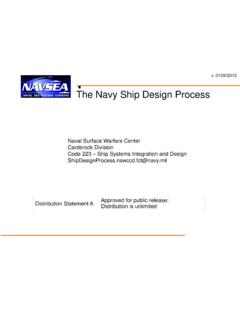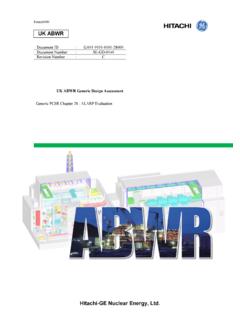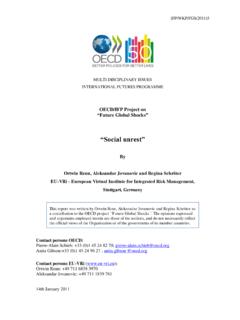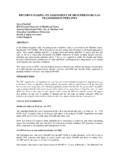Transcription of SET-BASED REQUIREMENTS, TECHNOLOGY, AND …
1 Warship 2017: Naval Submarines & UUVs, 14-15 June 2017, Bath, UK 2017: The Royal Institution of Naval Architects SET-BASED requirements , technology , and design development FOR SSNX M C Parker, Naval Sea Systems Command, USA M D Garner, Naval Sea Systems Command, USA J T Arcano, Naval Sea Systems Command, USA N Doerry, Naval Sea Systems Command, USA SUMMARY Maintaining affordable undersea capability will require modern design methodologies to minimize costly design changes while continuing to address evolving threats. An aggressive timeline and broad uncertainty around design requirements has led the Navy towards a SET-BASED strategy for requirements , technology and design development for future submarines [1].
2 SET-BASED methods enable informed and defendable decisions by systematically understanding tradeoffs prior to commitment [2], and have successfully been implemented on several ship programs [3] [4] [5]. This paper will provide an introductory background on SET-BASED methods including: definition and clarification of terminology, a history of application within the Naval Sea Systems Command, and a qualitative comparison to traditional point- based methods. Next, the paper will discuss the motivation for adopting SET-BASED methods for SSNX.
3 Finally, a detailed overview of a SET-BASED strategy for future submarine requirements , technology , and design development will be presented. NOMENCLATURE DSE design Space Exploration PMS 450 VIRGINIA Class Program Office RSDE Rapid Ship design Environment SBD SET-BASED design SSBN Ship, Submersible, Ballistic, Nuclear SSCTF Small Surface Combatant Task Force SSN Ship, Submersible, Nuclear SSNX Future Nuclear Attack Submarine VCS VIRGINIA Class Submarine 1. INTRODUCTION The United States Navy operates three classes of attack submarines: LOS ANGELES, SEAWOLF, and VIRGINIA.
4 The early-stage design work for these classes began in 1963, 1978, and 1988 respectively. The long-range naval shipbuilding plan calls for the continued block procurement of the VIRGNIA Class, with a plan to support construction of a follow-on class in 2034 [6]. These timelines indicate that future VIRGINIA blocks will still be in service post 2070, 80 years after design began, and a follow-on SSN, SSNX, could be in service post 2090. The timelines also suggest that requirements , technology , and design development are already behind the curve for the next generation submarine, Figure 1.
5 requirements , technology , and design development for submarines facing a 2070-2090 world is a major challenge, even greater than that for recent classes and blocks. The Block I VIRGINIA Class submarine (VCS) development effort benefitted from clear requirements , recent SEAWOLF Class technology research and development , and a very experienced workforce. Blocks II-IV have focused on evolutionary improvements and cost reduction. Block V adds a significant payload module amidships, but is technologically evolutionary.
6 The COLUMBIA Class SSBN in development incorporates many new technologies, but is a single mission platform with a clear requirement. In contrast, the requirements future VIRGINIA blocks and SSNX will be expected to meet and the technologies to do so are yet to be defined, and could significantly change throughout their lifecycle. Uncertainty in requirements and rapidly advancing technology defines a high risk development environment, further compounded by a workforce reduced in size and experience through attrition.
7 To meet this challenge, a SET-BASED strategy for submarine requirements , technology , and design development is being formulated. Traditionally the Navy has used iterative methods for submarine design . Though flexible and accurate, iterative methods require starting points, fixed requirements and technologies, and end with single design solutions. Iterative methods are far from ideal when the starting points are uncertain or likely to change. SET-BASED methods require starting sets, ranges of requirements and technologies, and end with a range of design solutions.
8 The variability of requirements and technologies is captured from the outset. The objective is to enable timely and robust acquisition decisions by systematically understanding tradeoffs prior to commitment. This paper provides an introductory background on SET-BASED methods, a history of application within the Naval Sea Systems Command, and a qualitative comparison to traditional point- based methods. Next, the paper discusses the motivation for adopting SET-BASED methods for future submarines. Finally, an overview of a SET-BASED strategy for requirements , technology , and design development is presented, including an example specific to SSNX.
9 Warship 2017: Naval Submarines & UUVs, 14-15 June 2017, Bath, UK 2017: The Royal Institution of Naval Architects Figure 1: Navy SSN design development Timelines [1] 2. SET-BASED design development OF SET-BASED design In the late twentieth century Japanese manufacturing firms were extensively studied because of their higher efficiency and quality relative to firms in the United States. A special focus was placed on the Toyota Motor Company because it was also outperforming other Japanese automotive companies. By traditional measures Toyota s production system seemed inefficient, yet put high quality automobiles on the market faster than the competition.
10 This was termed the First Toyota Paradox [7]. Part of the paradox was identified as strong parallel rather than sequential links between traditionally separate disciplines, manufacturing and product development , consistent with a Concurrent Engineering approach. Recognizing and studying the importance of Toyota s product development method to the company s production success, Ward, Liker, Cristiano, and Sobek identified what they called the Second Toyota Paradox ; the overall design phase was shorter and more efficient, yet purposefully withheld decisions, communicated ambiguous specifications, and produced excessive numbers of prototypes [7].







